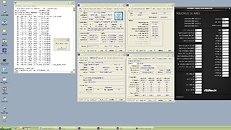- Joined
- Oct 9, 2007
- Messages
- 47,475 (7.50/day)
- Location
- Hyderabad, India
| System Name | RBMK-1000 |
|---|---|
| Processor | AMD Ryzen 7 5700G |
| Motherboard | ASUS ROG Strix B450-E Gaming |
| Cooling | DeepCool Gammax L240 V2 |
| Memory | 2x 8GB G.Skill Sniper X |
| Video Card(s) | Palit GeForce RTX 2080 SUPER GameRock |
| Storage | Western Digital Black NVMe 512GB |
| Display(s) | BenQ 1440p 60 Hz 27-inch |
| Case | Corsair Carbide 100R |
| Audio Device(s) | ASUS SupremeFX S1220A |
| Power Supply | Cooler Master MWE Gold 650W |
| Mouse | ASUS ROG Strix Impact |
| Keyboard | Gamdias Hermes E2 |
| Software | Windows 11 Pro |
German professional overclocker Dancop got the Intel Core i7-8700K processor to work on an ASUS ROG Maximus IX Apex (Z270) motherboard, something that's not supposed to work. CPU-Z screenshots seem to confirm this unholy union between the 6-core "Coffee Lake" processor and a 200-series chipset motherboard, using a custom "0084" BIOS dated 11th June, 2018. Dancop then proceeded to overclock the chip to 7344 MHz using extreme cooling, and 2x 8 GB (dual-channel) DDR4-4000 memory. This bench-stable build was then used to bag a SuperPi 32M world-record.
There's a rather big catch, though. Half the cores on the i7-8700K were disabled, and so was HyperThreading (not that it's relevant to SuperPi). The 3-core/3-thread chip was still bench-stable at 7344 MHz, crunching SuperPi 32M in a world-record 7.609 seconds. The clock speed was achieved by dialing up the multiplier to 73.0x, with the base-clock probably untouched, at 100.61 MHz (with the +0.61 MHz probably being variance). Supporting this clock was a blistering core voltage of 1.984 V. A liquid-nitrogen evaporator was used to tame the CPU and motherboard VRM. Find the validation in the source link below.


View at TechPowerUp Main Site
There's a rather big catch, though. Half the cores on the i7-8700K were disabled, and so was HyperThreading (not that it's relevant to SuperPi). The 3-core/3-thread chip was still bench-stable at 7344 MHz, crunching SuperPi 32M in a world-record 7.609 seconds. The clock speed was achieved by dialing up the multiplier to 73.0x, with the base-clock probably untouched, at 100.61 MHz (with the +0.61 MHz probably being variance). Supporting this clock was a blistering core voltage of 1.984 V. A liquid-nitrogen evaporator was used to tame the CPU and motherboard VRM. Find the validation in the source link below.


View at TechPowerUp Main Site











 How stupid!
How stupid!